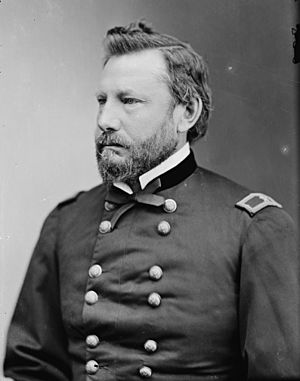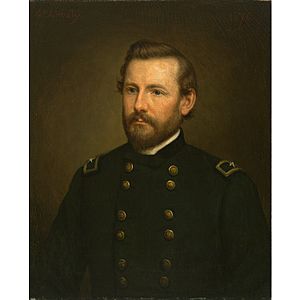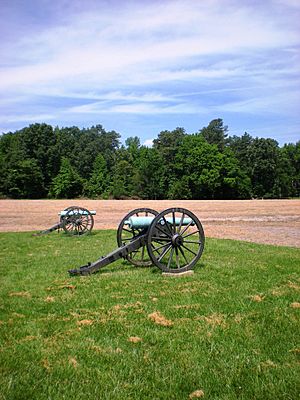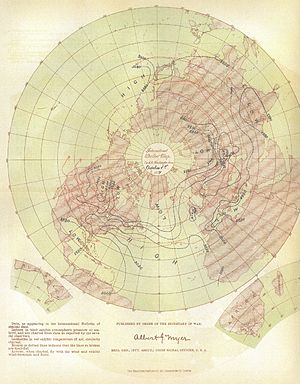Albert J. Myer facts for kids
Quick facts for kids
Chief Signal Officer, U.S. Army
Albert James Myer
|
|
|---|---|

Albert James Myer (1828-1880)
|
|
| Born | September 20, 1828 Newburgh, New York |
| Died | August 24, 1880 (aged 51) Buffalo, New York |
| Buried |
Forest Lawn Cemetery, Buffalo, New York
|
| Allegiance | United States of America |
| Service/ |
United States Army Union Army |
| Years of service | 1854–1880 |
| Rank | |
| Commands held | U.S. Army Signal Corps |
| Battles/wars | American Civil War |
Albert James Myer (born September 20, 1828 – died August 24, 1880) was an important figure in the United States Army. He was a surgeon and a general. Myer is often called the "father of the U.S. Army Signal Corps". This is because he was its first chief signal officer right before the American Civil War. He also invented a special way of sending messages called wig-wag signaling. This system used flags to send signals over long distances. Myer is also known as the "father of the U.S. Weather Bureau", which helps predict weather.
Contents
Early Life and New Ideas
Myer was born in Newburgh, New York. His family moved to Western New York. After his mother passed away, he was mostly raised by his aunt in Buffalo.
Myer worked as a telegrapher, someone who sends messages using electric signals, before going to college. He attended Geneva College (now Hobart College) when he was just 13. He graduated in 1847. He later earned his medical degree (M.D.) from Buffalo Medical College in 1851. While studying, he also worked part-time for a telegraph company. His medical paper was about a new sign language for deaf people. This paper showed ideas he later used for his flag signaling system.
Myer was very smart and always curious. He was known for taking an idea and exploring it fully. He also inherited a lot of money from his family.
Developing a Signal System
After practicing medicine in Florida, Myer joined the U.S. Army as an assistant surgeon in 1854. He was stationed in Texas. His main interest, besides medicine, was creating a way to send messages over long distances. He wanted to use simple codes and light equipment. This system used a single flag during the day or a lantern or torch at night. It was called wig-wag signaling or aerial telegraphy. Both sides used this system during the Civil War and afterward.
In 1858, the Army became interested in Myer's invention. A group of officers, led by Lt. Col. Robert E. Lee, looked at his ideas. Myer showed them his system in 1859. He convinced them to test it in the field. The tests around New York Harbor were successful. The Secretary of War suggested to Congress that the Army use Myer's system. He also recommended Myer become the chief signal officer. Congress agreed, and Myer was appointed a major and chief signal officer. This is how the Signal Corps started. Myer was then sent to New Mexico to test his system further during a campaign against the Navajos.
In 1857, Myer married Catherine Walden. They had six children together.
Signal Corps and the Civil War
On June 21, 1860, the War Department officially told Myer to create and lead the new U.S. Army Signal Corps. They gave him $2000 for equipment and promoted him to major. Myer had to find soldiers from other parts of the Army to join his new unit. The Signal Corps officially became an Army organization on March 3, 1863. At that time, Myer was promoted to colonel.
Before 1863, Myer worked under different generals. He served with Maj. Gen. Benjamin Butler at Fort Monroe, Virginia. There, he set up a training camp. Then, he became the chief signal officer for Maj. Gen. George B. McClellan's Army of the Potomac. He served in major campaigns like the Peninsula Campaign and the Battle of Antietam. During this time, Myer received special promotions for his bravery and actions in battles like Hanover Court House and Malvern Hill.
Interestingly, the first time Myer's signaling system was used in battle was by a Confederate officer. Captain Edward Porter Alexander used it at the First Battle of Bull Run. Alexander had worked with Myer during the New York field tests.
Telegraphy and Challenges
Besides flag signaling, Myer understood the need for electrical telegraphs in battle. He introduced wagons with special telegraph machines. These were called Beardslee telegraphs. They used a dial instead of Morse code, making them easier for soldiers to learn.
Myer's Signal Corps was separate from another group that handled telegraphs. This group was mostly civilians. Myer often argued about who should control all telegraph operations. He wanted to use trained telegraph operators in the Signal Corps instead of the Beardslee device. Because of these disagreements, Secretary of War Edwin M. Stanton removed Myer from his position on November 15, 1863. Myer was sent away from Washington, D.C..
While away, Myer wrote the Manual of Signals for the United States Army and Navy. In June 1864, he was appointed signal officer for the Military Division of West Mississippi. Here, Myer added a new task for the Signal Corps. He created a system to question soldiers who left the Confederate army and refugees who came into Union lines. He also developed a code for sending messages between land and sea forces. He helped plan communications for battles around Mobile. He even helped with the surrender of Fort Gaines.
While preparing for the Mobile campaign, Myer received bad news. His promotion to colonel and chief signal officer, given before his dismissal, had not been approved by the Senate. It was taken back, and he returned to his lower rank of major. Myer worked hard to fix this. He hired lawyers and used his political connections. On July 28, 1866, Congress reorganized the Signal Corps. Thanks to the influence of Lt. Gen. Ulysses S. Grant and President Andrew Johnson, Myer became chief signal officer again, with the permanent rank of colonel. He was very happy when he heard this news, especially since his old rival, Edwin Stanton, had to tell him. His new job included controlling the telegraph service, which was the issue that had caused his dismissal.
On December 3, 1867, President Andrew Johnson nominated Myer for a special promotion to brevet brigadier general. This was to honor him for forming the Signal Corps. The United States Senate confirmed this promotion in February 1868. Myer officially became a brigadier general in the regular Army on June 16, 1880, just two months before he died. His soldiers nicknamed him "Old Probabilities" because of his work with weather.
After the War: Weather and More
On February 9, 1870, the U.S. Congress gave the Signal Corps a new job. They were to observe weather at military bases and other places across the United States. They would also warn ships on the Great Lakes and coasts about storms using telegraphs and signals. This job used to be done by the Smithsonian Institution. It was given to General Myer's Signal Corps partly because of his interest in storm warnings. This was the beginning of the U.S. Weather Bureau, which is now the National Oceanic and Atmospheric Administration. In 1873, at a meeting in Vienna, Myer suggested that weather stations be set up all over the world. He wanted them to share daily weather observations at the same time. This was the start of the World Meteorological Organization.
Myer also helped develop the heliograph in the U.S. Army. A heliograph is a device that uses mirrors to send messages by reflecting sunlight. In 1877, he got heliograph instruments from the British Army to test. He sent them to General Nelson A. Miles in Montana. Miles became very skilled with the heliograph. He used it effectively in campaigns against the Apache people in Arizona.
Myer led the Signal Corps from August 21, 1867, until he died from a kidney disease in Buffalo, New York, in 1880. He is buried in the Walden-Myer Mausoleum at Forest Lawn Cemetery in Buffalo.
Legacy

Albert James Myer is remembered in several ways:
- Fort Myer in Virginia was named after him in 1881.
- A U.S. Army cable ship, the Albert J. Myer, was built in 1945.
- The Albert J. Myer Center, the Signal Headquarters building, is at Fort Monmouth, New Jersey.
- The General Albert J. Myer Forecast Facility is at the Buffalo Niagara International Airport.
- Hobart College gave Myer an honorary law degree in 1872.
- Union College gave him an honorary Ph.D. in 1875.
See Also
- List of American Civil War generals (Union)



